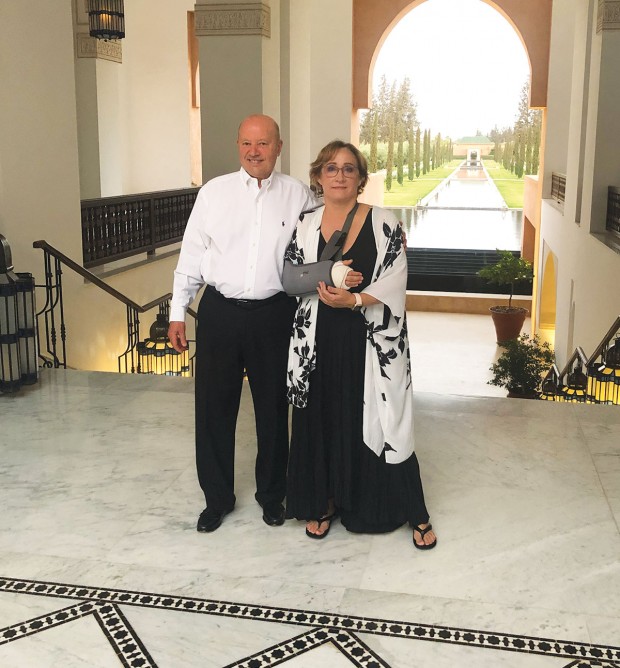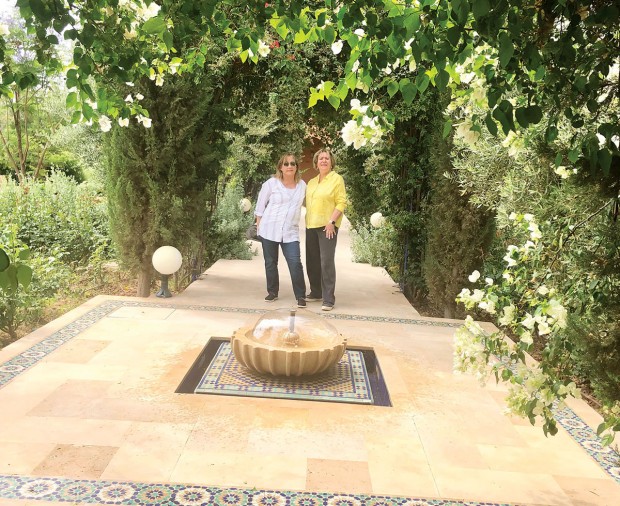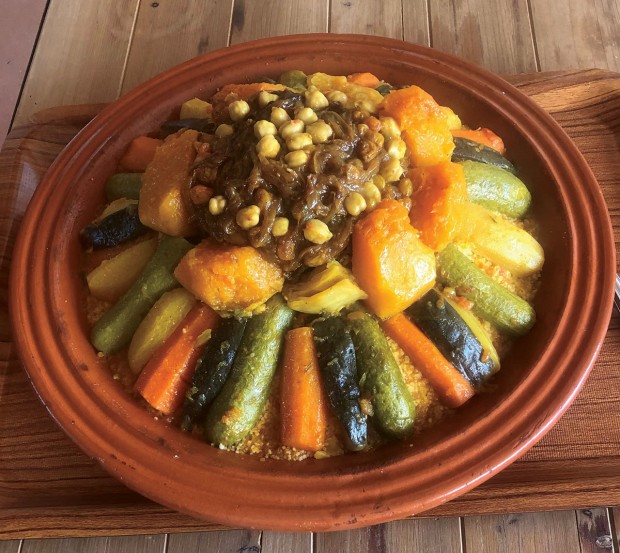A Moroccan Love Story


MOROCCAN VISTA While studying abroad in Paris as a college student, Lisa El Hafi fell in love with Morocco. It was during that same time that she met Moroccan medical student Salah El Hafi. Later, the two started dating and married. Eventually, they settled in Houston while continuing to visit Salah’s homeland and exploring the country. Now they have a second home in Marrakech. Pictured: The El Hafis at the Oberoi Hotel just outside Marrakech, about 10 minutes from their home; the hotel is owned by the family of their friend Anissa Balafrej.
Lisa El Hafi – then Lisa Laufbahn — fell in love with Morocco on her first trip there in 1974 as a college junior studying in Paris. Little did she know her next trip there would be for her Moroccan wedding.
As it turned out, Morocco was destined to be a central part of Lisa’s life. During her college years, she met Moroccan medical student Salah El Hafi, and the two became friends. But Lisa was dating someone else, and then she graduated and returned to the States. But Salah never forgot Lisa, and after two years persuaded her ex-boyfriend to share her address and tracked her down in Boston, where he proposed to her – and she accepted.
She moved back to Paris in 1976, where they had their civil ceremony – Lisa is Jewish, but because they planned to eventually live in Morocco, they had a Muslim ceremony for legal expediency.
“I was, at the time, and I still am very open-minded regarding cultural traditions,” said Lisa. “So it was fine with me, even though it was all in Arabic.”
The next year, in Rabat, Salah’s hometown, his parents planned a traditional Moroccan wedding, and it was magical. Lisa wore an elaborate caftan, there was lively traditional music with dancing, and those memories wove themselves into the tapestry of their lives.
They returned to Paris, where their son Adam was born the following year. Their next trip was when Adam was three months old. They would go back at least every two years to keep the relationship with Salah’s family and his mother country alive.
“I wanted them to know their grandparents, so we spent most of their youth visiting here or having the family visiting us in Houston,” said Lisa, speaking from the couple’s second home in Marrakech. “The family connection is really important to us.”
Eventually they moved back to the States, first to Connecticut, where Salah did his medical residency. Their daughter Mia was born there in 1980. Then they moved to Birmingham, Alabama, and New Orleans, where Salah completed his cardiology training before settling in Houston, “as soon as we could,” says Lisa with a laugh. There Salah began his cardiology practice in 1984.

Lisa, left, at home in Dar Lila, enjoying the gardens with Anissa, the architect who designed their home. Lisa and Salah call the home Dar Lila; “dar” means “house,” and it was named for the couple’s first granddaughter, Lila.
The journeys to Salah’s motherland continued, and the children grew up learning about the culture. Morocco’s complex history begins with the indigenous Berbers, who inhabited Morocco before the arrival of the Arabs in the eighth century.
“The country was occupied by the Spanish in the north and in the Sahara,” writes Lisa, an author of several books, in “Morocco: What You Need to Know,” which she was inspired to write for our readers. From 1912-1956, Morocco was a French and Spanish protectorate. “The result is a society where the architecture is a mélange of Moorish palaces and Art Deco banks and post offices built by the French in the 1920s.”
The family spent visits in the early years mostly with family in the coastal capital city of Rabat, often referred to as the “White City” because of its many white buildings. Like many Moroccan cities, Rabat has its culturally rich medina, a walled Old City with its winding, narrow streets and ancient souks, or markets.
They sometimes went to Salé across the river Bouregreg and took family excursions to the Mediterranean resort town of Cabo Negro, with its expansive beaches and crystalline waters. Cabo Negro is near the picturesque Rif Mountains and another of Lisa’s favorites: Tétouan, a city with a major Andalusian influence, as it served as a refuge for Jews and Muslims expelled from Spain. Morocco as a whole took in many Jews during the expulsion that began in 1492, and later the Spanish Moors, who were expelled in the early 1600s.
The family also visited Meknes, where Salah’s sister lives. Meknes has been called an open-air museum. Its impressive medina, listed as a UNESCO World Heritage Site, is entered through the Bab Mansour Gateway, considered a masterpiece of Hispano-Moorish art. Also near Meknes is the Roman archaeological site of Volubilis, dating to the 3rd century B.C. Volubilis is considered one of the richest sites of North Africa, known for its many fine buildings, well-preserved mosaics, bronze and marble statues, and extensive inscriptions.
Lisa tried to teach her children French, the second language of Morocco. To this day, Mia makes regular visits, bringing Lila, 12, and Sammy, 9. Adam comes from time to time with son Max, 12.
Over the years the couple also came to Morocco for Salah’s medical conventions, three in Marrakech. Treasured memories included stays in the 100-year-old Mamounia, a classic palace turned hotel featured in the classic 1956 Hitchcock film, The Man who Knew Too Much. “Winston Churchill was fascinated by Marrakech and used to stay at the Mamounia and paint the beautiful scenery toward the end of World War II,” said Lisa.
In the end it was Marrakech that really captured their hearts.
“Marrakech is a unique place, with the weather, the scenery and the people, the changing colors of the sky, the magic of the palm trees,” said Salah. “You can be swimming and looking at the snow-capped Atlas Mountains.”
A two-hour drive from Casablanca, where most visitors arrive, the city lies on the edge of the Atlas Mountains. It is known as the Red City, because of its buildings and ramparts of beaten clay.
“Visitors typically begin with a visit to Jemaa el-Fna, the square with its snake charmers, monkeys, ancient storytellers spinning their tales (in Arabic) and natives hawking everything from local wares to counterfeit DVDs,'' wrote Lisa. “From there you can wind your way through the serpentine alleys of the medina, where you can buy souvenirs, caftans, and babouche (traditional leather shoes). Stands with freshly ground spices, olives and pickled lemons are gradually replaced by stores selling silver and gold jewelry and brass light fixtures and carved wooden tables.”
Hotels for all budgets and tastes are available in the medina and also in the Palmeraie, a palm-filled oasis outside the city that has grown into a major tourism base. Lisa recommends staying at a riad; these traditional homes converted into boutique hotels give an authentic taste of Moroccan life. Local cuisine is delicious and distinctive, including traditional tagines and couscous, with an array of international cuisines as well.
One must-see, she says, is the Mellah, the old Jewish Quarter, especially for those interested in Jewish history. The government has recently refurbished the synagogue and the cemetery, and many Israelis come to visit the graves of their ancestors. She recommends the Mellah as a cleaner, less crowded shopping alternative to the medina with abundant shops and restaurants.
She and Salah enjoy taking a respite from the city in the Atlas Mountains. A favorite spot is the Kasbah Tamadot near Asni. This luxurious hotel founded by Sir Richard Branson and his mother features local women’s handicrafts. The price is prohibitive for many, so the El Hafis make the trip to enjoy a sumptuous lunch and walk the lush and manicured gardens.
Another favorite is the 19th-century Bahia Palace, with its impressive collection of stuccos, paintings, and mosaics. Its two-acre garden features rooms opening into courtyards, each filled with cypress, palm, orange, and lemon trees.
“Each room is different,” wrote Lisa. “Some were used as official salons, others housed the Vizier’s women (wife, concubines and, yes, slaves).”
Other favorite sites include Dar El Bacha (literally, House of the Pacha, or governor); Koutoubia Mosque, founded in 1147 and the largest in Marrakech, with a towering 253-foot minaret; the Menara Gardens, built in the 12th century by the ruling caliphate, Abd al-Mu'min; M Avenue, the trendy new mixed-use development in the city center connecting the Menara Gardens to Mohammed VI Avenue, filled with a diverse array of shops, restaurants, and hotels. For Lisa, the main attraction of M Avenue is the interactive cultural center called the "Meydene," with a permanent exhibition space, a 400-seat auditorium, and a Morocco-themed virtual light and sound show projected on the walls of the center.

The El Hafis eat couscous every Friday, the Muslim holy day, without exception. Usually it is served in a typical Moroccan dish like this one called a tagine.
Salah eventually purchased land on the outskirts of the city when he received his inheritance. For 30 years it sat there, grazed by sheep and goats from the neighboring village. When the children grew up and left home, Salah began to think more seriously about building a house there.
“I couldn’t imagine building a house in Marrakech – it’s daunting – until my friend said, ‘I’ll do it,’” said Lisa.
Salah’s childhood friend, Dr. Said Balafrej, is married to an architect, Anissa – Lisa’s “sister from another mother,” as she refers to her. Anissa proposed designing the home and the couple accepted. They called the home Dar Lila; “dar” means “house,” and it was named for the couple’s first granddaughter, Lila.
The site evolved from a weedy patch to a classic Moroccan-style home, bright and airy with patios and gardens, a pool and even a hammam, a Turkish bath. The gardens are filled with palm trees and the house has spectacular views of the Atlas Mountains, where the couple never tires of watching the iridescent sunrises and sunsets.
“It was a dream come true to be able to build our house in Marrakech and to be able to spend time with family and friends,” said Salah.
“We have olive trees and all kinds of fruit trees and roses,” said Lisa. They also have animals – goats, chickens, and a donkey. They love the calm of the countryside, which has gradually developed over time with a number of other homes and riads.
The house would become a gathering place for family and the base for Lisa’s writing. Author of historical fiction novels The New Woman and The Empty Mirror, Lisa spoke to us from Dar Lila, where she was working on a new book about Morocco in the 1920s.
The family’s relationship with Morocco has shaped them all in many ways. Lisa watches the grandchildren interact with the locals, picking up some Arabic and immersing themselves in the culture.
“Traveling, you look at the US in a different way,” she said. “There’s so much more going on in the world than people know; many don’t understand the different cultures, the different history – they just haven’t had the exposure.”
There’s another reason she’s glad to have a Moroccan escape. “With all the craziness going on right now, it's very good to be here and away from that. Life here is simpler; we don’t talk politics with our friends at all. And having some distance helps me not to worry about the stuff I can’t do anything about anyway.”
Want more buzz like this? Sign up for our Morning Buzz emails.
To leave a comment, please log in or create an account with The Buzz Magazines, Disqus, Facebook, or Twitter. Or you may post as a guest.


